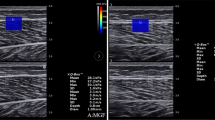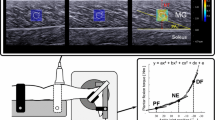Abstract
Purpose
The aim of this study is to quantitatively assess lower limbs muscle elasticity in a court of healthy subjects and to evaluate the influence of technical variables (e.g., diameter of the ROI—region of interest) and examined subjects’ characteristics (e.g., sex, levels of physical activity, side evaluated) on muscle stiffness.
Materials and methods
54 healthy subjects (48 men, 6 women) were evaluated for a total of 108 lower limbs. Shear wave elastography was performed with a multifrequency linear probe (15–4 MHz). Two radiologists performed the evaluation of lower limbs from left to right side (first calf and then thigh). The measures were taken on gastrocnemius and on femoral biceps muscle belly. We chose to place for this study two ROIs of 4 and 2 mm of diameter.
Results
The mean muscle stiffness was 1.98 ± 0.48 (range between 1.89 ± 0.36 and 2.15 ± 0.57 m/s). The difference in muscle stiffness between left and right side of the body and between different levels of physical activity never became statistically significant (p value between 0.314 and 0.915). Only in one test out of eight the difference of muscle stiffness between male and female resulted statistically significant (p value 0.020). When comparing the measurement obtained with a 2 and 4 mm diameter ROIs the values were statistically different only for the left thigh (p value 0.028).
Conclusion
Our study, despite its limitations (low sample and low female population), seems to give some clear advice: physiological or technical factors do not determine statistically significant differences on passive muscle stiffness.
Sommario
Scopo
lo scopo del nostro studio è quello di valutare quantitativamente l’elasticità dei muscoli degli arti inferiori in una coorte di soggetti sani e di valutare l’influenza di variabili tecniche (ad esempio il diametro della regione di interesse) e delle caratteristiche dei soggetti esaminati (ad esempio il livello di attività fisica, il lato valutato) sulla stiffness muscolare.
Materiali e metodi
sono stati valutati 54 soggetti sani (48 uomini e 6 donne) per un totale di 108 arti inferiori. L’elastografia Shear Wave è stata realizzata con sonda lineare multifrequenza (15–4 MHz). Due radiologi hanno realizzato la valutazione degli arti inferiori da sinistra a destra (prima il polpaccio e poi la coscia). Le misure sono state realizzate sui ventri muscolari del gastrocnemio e del bicipite femorale. Per questo studio si è deciso di posizionare 2 ROI (regioni di interesse) di 2 e 4 mm di diametro.
Risultati
L’elasticità media muscolare rilevata è di 1,98 ± 0,48 m/s (valori compresi tra 1,89 ± 0,36 e 2,15 ± 0,57 m/s). La differenza nella stiffness muscolare tra lato sinistro e destro del corpo e per diversi livelli di attività fisica non è mai diventata statisticamente significativa (p value compresi tra 0,314 e 0,915). Solo in un test statistico su otto la differenza nella stiffness muscolare tra uomini e donne è risultata statisticamente significativa (p value 0,020). Nella comparazione tra valori ottenuti con le ROI da 2 e 4 mm la differenza è risultata statisticamente significativa solo per la coscia di sinistra (p value 0,028).
Conclusioni
il nostro studio, nonostante le sue limitazioni (come il campione ridotto e la scarsa rappresentazione della popolazione femminile), sembra fornire alcune indicazioni: i fattori tecnici e fisiologici non sembrano essere in grado di determinare differenze statisticamente significative della stiffness muscolare passiva.

Similar content being viewed by others
References
Dresner MA, Rose GH, Rossman PJ, Muthupillai R, Manduca A, Ehman RL (2011) Magnetic resonance elastography of skeletal muscle. J Magn Reson Imaging 13:269–276
Mariappan YO, Glaser KJ, Lehman RL (2010) Magnetic resonance elastography: a review. Clin Anat 23:497–511
De Ledinghen V, Vergniol J (2008) Elastographie Impulsionnelle (Fibroscan). Gastroenterol Clin Biol 32:58–67
Sarvazyan AP, Rudenko OV, Swanson SD et al (1998) Shear wave elasticity imaging: a new ultrasonic technology of medical diagnostics. Ultrasound Med Biol 24(9):1419–1435
Bercoff J, Tanter M, Fink M (2004) Supersonic Shear Imaging: a new technique for soft tissue elasticity mapping. IEEE Trans Ultrason Ferroelectr Freq Control 51(4):396–409
Ami O, Lamazou F, Mabille M et al (2009) Real time transvaginal elastosonography of uterine fibroids. Ultrasound Obstet Gynecol 34:486–488
Kiss MZ, Hobson MA, Varghese T et al (2006) Frequency-dependent complex modulus of the uterus: preliminary results. Phys Med Biol 51:3683–3695
Zhi H, Xiao XY, Yang HY et al (2008) Semi-quantitating stiffness of breast solid lesions in ultrasonic elastography. Acad Radiol 15:1347–1353
Kumm TR, Szabunio MM (2010) Elastography for the characterization of breast lesions: initial clinical experience. Cancer Control 17(3):156–161
Regini E, Bagnera S, Tota D et al (2010) Role of sonoelastography in characterising breast nodules. Preliminary experience with 120 lesions. Radiol Med 115:551–562
Roulot D, Czernichow S, Le Clésiau H et al (2008) Liver stiffness values in apparently healthy subjects: influence of gender and metabolic syndrome. J Hepatol 48(4):606–613
Takemoto R, Nakamuta M, Aoyagi Y et al (2009) Validity of Fibroscan values for predicting hepatic fibrosis stage in patients with chronic HCV infection. J Dig Dis 10:145–148
Rubaltelli L, Corradin S, Dorigo A et al (2009) Differential diagnosis of benign and malignant thyroid nodules at elastosonography. Ultraschall Med 30:175–179
Cantisani V, Grazhdani H, Drakonaki E (2015) Strain US elastography for the characterization of thyroid nodules: advantages and limitation. Int J Endocrinol 2015:908575
Rago T, Vitti P (2009) Diagnostic value of elastosonographically determined strain index in the differential diagnosis of benign and malignant thyroid nodules. 2009. Q J Nucl Med Mol Imaging 53:455–464
Cantisani V, Lodise P, Di Rocco G (2015) Diagnostic accuracy and interobserver agreement of quasistatic ultrasound elastography in the diagnosis of thyroid nodules. Ultraschall Med 36(2):162–167
Cosgrove D, Piscaglia F, Bamber J (2013) EFSUMB guidelines and recommendations on the clinical use of ultrasound elastography. Part 2: clinical applications. Ultraschall Med 34(3):238–253
Botar-Jid C, Damian L, Dudea SM et al (2010) The contribution of ultrasonography and sonoelastography in assessment of myositis. Med Ultrasonogr 12(2):120–126
Drakonaki E, Allen GM (2010) Magnetic resonance imaging, ultrasound and real-time ultrasound elastography of the thigh muscles in congenital muscle dystrophy. Skelet Radiol 39:391–396
Yoshida K, Itoigawa Y, Maruyama Y, Saita Y, Takazawa Y, Ikeda H, Kaneko K, Sakai T, Okuwaki T (2016) Application of shear wave elastography for the gastrocnemius medial head to tennis leg. Clin Anat. doi:10.1002/ca.2278
Chino K, Takahashi H (2016) Measurement of gastrocnemius muscle elasticity by shear wave elastography: association with passive ankle joint stiffness and sex differences. Eur J Appl Physiol 116(4):823–830. doi:10.1007/s00421-016-3339-5 Epub 2016 Feb 13
Hatta T, Giambini H, Zhao C, Sperling JW, Steinmann SP, Itoi E, An KN (2016) Biomechanical effect of margin convergence techniques: quantitative assessment of supraspinatus muscle stiffness. PLoS ONE 11(9):e0162110. doi:10.1371/journal.pone.0162110
Andonian P, Viallon M, Le Goff C, de Bourguignon C, Tourel C, Morel J, Giardini G, Gergelé L, Millet GP, Croisille P (2016) Shear-wave elastography assessments of quadriceps stiffness changes prior to, during and after prolonged exercise: a longitudinal study during an extreme mountain ultra-marathon. PLoS ONE 11(8):e0161855. doi:10.1371/journal.pone.016185
Bhatia KS, Cho CC, Tong CS, Lee YY, Yuen EH, Ahuja AT (2012) Shear wave elastography of focal salivary gland lesions: preliminary experience in a routine head and neck US clinic. Eur Radiol 22(5):957–965
Ewertsen C, Carlsen JF, Christiansen IR, Jensen JA, Nielsen MB (2016) Evaluation of healthy muscle tissue by strain and shear wave elastography—dependency on depth and ROI position in relation to underlying bone. Ultrasonics 71:127–133. doi:10.1016/j.ultras.2016.06.007
Chino K, Kawakami Y, Takahashi H (2015) Tissue elasticity of in vivo skeletal muscles measured in the transverse and longitudinal planes using shear wave elastography. Clin Physiol Funct Imaging. doi:10.1111/cpf.12315. [Epub ahead of print]
Author information
Authors and Affiliations
Corresponding author
Ethics declarations
Conflict of interest
Authors have no conflict of interest to declare related to this study.
Ethical approval
All procedures followed were in accordance with the ethical standards of the responsible committee on human experimentation (institutional and national) and with the Helsinki declaration of 1975, as revised in 2000.
Informed consent
The patient provided written informed consent to enrolment in the study and to the publication of information that could potentially lead to his identification.
Human and animal studies
The study described in this article does not involve the use of animal subjects.
Rights and permissions
About this article
Cite this article
Bortolotto, C., Lungarotti, L., Fiorina, I. et al. Influence of subjects’ characteristics and technical variables on muscle stiffness measured by shear wave elastosonography. J Ultrasound 20, 139–146 (2017). https://doi.org/10.1007/s40477-017-0242-9
Received:
Accepted:
Published:
Issue Date:
DOI: https://doi.org/10.1007/s40477-017-0242-9




